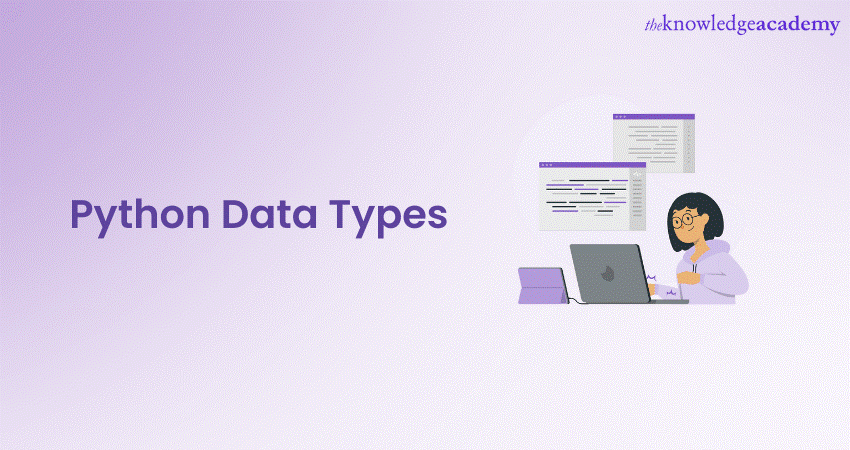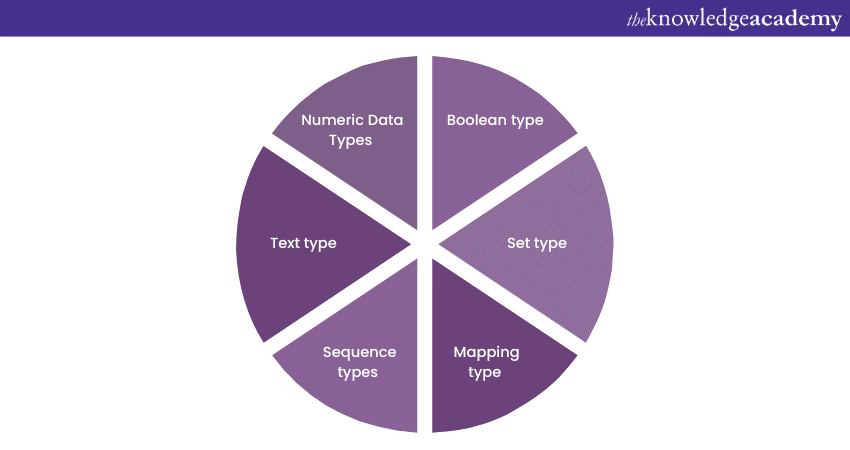We may not have the course you’re looking for. If you enquire or give us a call on 01344203999 and speak to our training experts, we may still be able to help with your training requirements.
Training Outcomes Within Your Budget!
We ensure quality, budget-alignment, and timely delivery by our expert instructors.

If you are new to Python programming, then get ready to hear the term Python Data Types more often. You might wonder why the word “Data Types” is generally used in programming! However, grasping the fundamentals of Data Types in Python can empower you to handle data with finesse and efficiency.
But how can these Data Types help one handle programming, and why are they important to Python? Read this blog to discover the essence of Python Data Types. Also, learn how they lay the foundation for creating robust and dynamic programs.
Table of Contents
1) What are Data Types?
2) Importance of Python Data Types
3) Basic Data Types in Python
a) Numeric Data Types
b) Text type
c) Sequence types
d) Mapping type
e) Set type
f) Boolean type
4) Conclusion
What are Data Types?
In Computer Programming, Data Types play a fundamental role in defining the nature and characteristics of data that can be manipulated and processed within a program. In essence, Data Types are a classification system that allows programmers to allocate memory and specify the kind of values a particular variable or data structure can hold. Each Data Type has its unique properties, constraints, and operations associated with it.
In Python, Data Types are essential building blocks that enable developers to create flexible and efficient applications. Python offers a rich set of built-in Data Types catering to various data representations and computations.
By understanding Python Data Types, developers can write efficient and bug-free codes. It also enables them to perform operations appropriate to the data and ensures compatibility and consistency throughout the program’s execution.
Moreover, variables are not explicitly declared with these types in Python, thanks to the language’s dynamic typing. Instead, this programming language infers the Data Type of a variable based on the value assigned to it. This flexibility allows for rapid development and simplifies the coding process.
As a result, Python’s extensive range of built-in Data Types empowers developers to harness the full potential of the language. They also help in crafting sophisticated and robust programs with ease.

Importance of Python Data Types
Data Types are crucial in Python programming, making it one of the most powerful and versatile programming languages available. They offer a myriad of benefits that contribute to the efficiency, reliability, and flexibility of programs. Let's explore the significance of Python Data Types and understand why they are of paramount importance to developers:
Memory allocation and optimisation
They allow Python to allocate memory for variables and data structures efficiently. By specifying the Data Type of a variable, the programming language can reserve the appropriate amount of memory. As a result, it minimises wastage and optimises memory usage. This optimisation is particularly essential when dealing with large datasets or resource-constrained environments.
Enhanced performance
With the correct use of Data Types, Python programs can achieve better performance. Operations involving specific these components are often more efficient, as the programming language can apply optimised algorithms tailored to those types.
For instance, Numeric Data Types like integers and floating-point numbers have dedicated arithmetic operations that are faster than generic ones.
Type safety and error handling
Python's strong typing system, enforced through Data Types, ensures type safety. It prevents unintended operations on incompatible Data Types. As a result, it reduces the likelihood of runtime errors and bugs. This leads to more reliable and robust code.
Code clarity and readability
Explicitly specifying the types of data enhances code clarity and readability. When reading someone else’s code or revisiting your own after a significant time gap, knowing the Data Types used helps understand the purpose. It also helps in determining the context of variables and data structures.
Looking to kickstart your coding journey? Register now for our Programming Training.
Function parameter definition
Data Types aid in defining function parameters. They make it easier to understand what types of arguments a function accepts. This provides clear guidance to developers. As a result, it prevents the passing of incorrect Data Types as function arguments.
Interoperability and data integrity
Python's Data Types ensure seamless data exchange between different parts of a program and even between different programs. This interoperability is vital when integrating Python code with other languages or systems. Additionally, these components safeguard the integrity of data throughout its lifecycle, preventing unintended modifications.
Facilitating code maintenance and refactoring
When modifying or refactoring code, Data Types help maintain consistency in data representations. This makes the process smoother and reduces the risk of introducing errors.
Efficient memory utilisation in Collections
In Collections like lists and dictionaries, homogeneous Data Types allow for more efficient memory utilisation. Storing elements of the same type consecutively in memory reduces memory fragmentation and improves performance.
Data validation and input handling
Data Types play a significant role in data validation and input handling. They enable programmers to ensure that data received from users or external sources conform to the expected format and type. As a result, it enhances the overall reliability of the application.
Take the first step in becoming a skilful Django developer by signing up for our Python Django Training.
Basic Data Types in Python
Python, as a dynamically typed language, provides a collection of basic Data Types that serve as the building blocks for data representation and manipulation. These form the foundation of any Python program. So, let's explore the basic Python Data Types and understand their characteristics:

1. Numeric Data Types
Numeric Data Types in Python encompass three primary categories:
a) Integer: Integers are whole numbers, both positive and negative, without any fractional part. They can represent a wide range of numerical values and are commonly used for counting and mathematical operations. Its example includes:
x = 10
y = -25
z = 0
b) Float: Floats are numbers with decimal points, enabling the representation of real numbers. They are used for more precise mathematical calculations, including scientific and financial computations. Its example include:
pi = 3.14159
radius = 2.5
c) Complex: Complex numbers consist of a real and an imaginary part and are represented as a + bj, where a and b are real numbers. j represents the square root of -1. They are used in advanced mathematical and engineering applications. Its example includes:
z = 2 + 3j
2. Text type
Strings are sequences of characters and are used to represent textual data. They can be enclosed within single, double, or triple quotes. Python treats strings as immutable objects, meaning their contents cannot be changed after creation. Its example includes:
name = "John Doe"
message = 'Hello, how are you?'
Gain the expertise to analyse data and unlock the power of decision-making. Join our Python Data Science Training now!
3. Sequence types
Sequence types in Python encompass two primary categories:
a) List: Lists are dynamic collections that can store elements of different Data Types. They are mutable, allowing for easy modification of elements. Lists are versatile and widely used for data storage and manipulation. Its example includes:
numbers = [1, 2, 3, 4, 5]
names = ["Alice", "Bob", "Charlie"]
mixed_list = [1, "hello", 3.14, True]
b) Tuple: These are similar to Lists but immutable, meaning their elements cannot be changed after creation. They are commonly used to represent fixed collections of data. Example includes:
coordinates = (10, 20)
colors = ("red", "green", "blue")
4. Mapping type
Dictionaries are associative data structures that store data as key-value pairs. They allow for quick access to values based on their corresponding keys. They are extensively used to represent real-world entities and facilitate efficient data retrieval. Their example includes:
person = {"name": "John", "age": 30, "city": "London"}
5. Set type
Sets are unordered collections of unique elements. They are useful for various operations like removing duplicates from a list and testing membership. Python provides a set Data Type along with corresponding set operations. Their example includes:
fruits = {"apple", "banana", "orange"}
Build a solid foundation in two of the most powerful programming languages by signing up for our Introduction To Programming With Python And Java Training.
6. Boolean type
The Boolean Data Type represents binary truth values, either True or False. They are integral in decision-making and flow control in Python programming. Its example includes:
is_raining = True
is_sunny = False
Conclusion
Python Data Types form the backbone of any Python programming. By understanding and utilising the appropriate types of data effectively, programmers can efficiently handle, manipulate, and represent data. As a result, they can create elegant and robust solutions for a wide array of real-world challenges.
Gain skills to build dynamic applications and advance your career in programming by signing up for our Python Programming Training.







 Top Rated Course
Top Rated Course



 If you wish to make any changes to your course, please
If you wish to make any changes to your course, please


